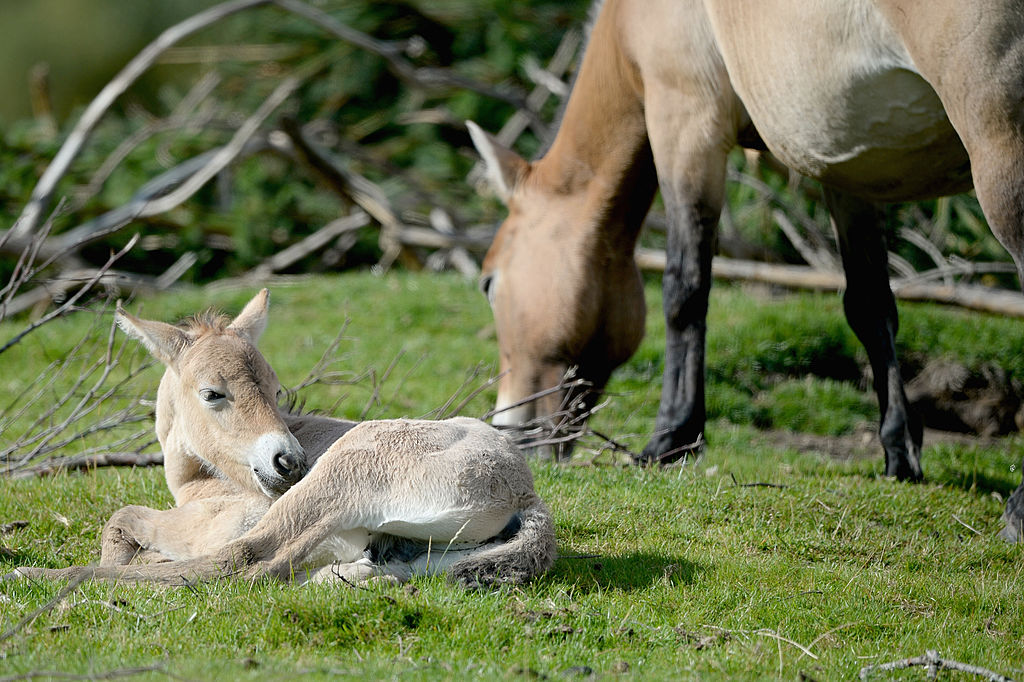Summary of Rare Male Przewalski Foal Born in California Zoo Following Cloned Colt:
A rare Przewalski foal was recently born at a California zoo following the successful cloning of a colt. The Przewalski’s horse is a critically endangered species considered extinct in the wild until 1996. The new foal is gaining strength and blending in with the rest of the herd. The colt’s cloning is expected to restore genetic variety in the endangered population. The Przewalski’s horse is native to Europe and Asia but went extinct due to human competition and environmental changes. The species is now limited to China, Mongolia, and Kazakhstan reintroduction areas. The cloning project aims to increase genetic diversity to ensure the species’ survival.
– A rare Przewalski foal was recently born at a California zoo.
– This is significant because Przewalski’s horse was considered extinct in the wild until 1996.
– The foal was born to parents who include a cloned colt, which is expected to help restore genetic diversity to the critically endangered Przewalski population.
– The Przewalski horse is now restricted to reintroduction areas in China, Mongolia, and Kazakhstan.
– The species is recovering from a historical bottleneck, and cloning is being made to restore genetic diversity
In a remarkable turn of events, a rare and critically endangered Przewalski foal was recently born at a California zoo. This news comes on the heels of the arrival of a cloned colt, sparking excitement and hope for the conservation of this incredible species.
The birth of the Przewalski foal is a significant milestone for the San Diego Zoo Wildlife Alliance. The foal, born on June 11 to mother Nikki and father Ziggy, is still finding its footing but is closely sticking to its mother. The unnamed colt has seamlessly blended with the dozen horses that make up the Przewalski’s horse herd.
What makes this birth even more fascinating is the presence of a second foal in the herd, born in April, resulting from successful cloning. The cloned colt is expected to restore genetic variation within the critically endangered Przewalski population.
The Przewalski’s horse was once considered extinct in the wild until 1996. According to the San Diego Zoo Wildlife Alliance, zoos worldwide have played a vital role in the species’ survival over the last four decades. These remarkable horses once roamed throughout Europe and Asia, eventually moving east and going extinct in the wild due to various factors, including competition with humans and cattle and environmental changes.
Today, Przewalski’s horse is limited to reintroduction areas in China, Mongolia, and Kazakhstan, as highlighted by the Smithsonian Institute. The last truly wild horses can be found in Mongolia, known as Przewalski’s horses. Interestingly, they are distant cousins of the domestic horse, which was previously believed to be their ancestor. Based on mitochondrial DNA, they may have split from a common ancestor around 500,000 years ago.
It is worth noting that the “wild” horses seen in Australia, North America’s western plains, and the barrier islands off the East Coast are domestic horses that have escaped from ranches and farms.
The Przewalski’s horse population is slowly recovering from a significant historical bottleneck, much like many other endangered species. The current population of over 2,000 Przewalski horses is descended from just 12 individuals. While efforts have been made to reintroduce them into the wild in Mongolia and China during the 1990s, genetic diversity must be restored for the species to thrive.
In 2018, a groundbreaking collaboration between Revive & Restore, the San Diego Zoo Wildlife Alliance, and ViaGen Pets and Equine began with te goal of cloning the first-ever Przewalski’s horse. Using a cell line cryopreserved since 1980 at the San Diego Zoo Wildlife Alliance Frozen Zoo, they successfully cloned a Przewalski’s horse named Kurt, worn on August 6, 2020. Kurt possesses valuable genetic diversity that has the existing gene pool.
Building upon their success, a second Przewalski’s horse clone was born on February 17, 2023, using the same cell line. This clone and Kurt might be the first cloned creature to contribute to restoring their species’ genetic diversity. The efforts of these dedicated organizations give hope for the long-term survival and conservation of Przewalski’s horse.
In conclusion, the birth of the rare Przewalski foal at a California zoo, following the arrival of a cloned colt, marks a significant milestone in the conservation of this critically endangered species. The Przewalski’s horse, once considered extinct in the wild, is now slowly recovering thanks to the efforts of zoos and conservation organizations worldwide. Through cloning, scientists aim to restore genetic diversity and ensure the future survival of these remarkable horses. The Przewalski foal’s story is a testament to the resilience and ingenuity of the human spirit when it comes to protecting the natural world and its precious inhabitants.


